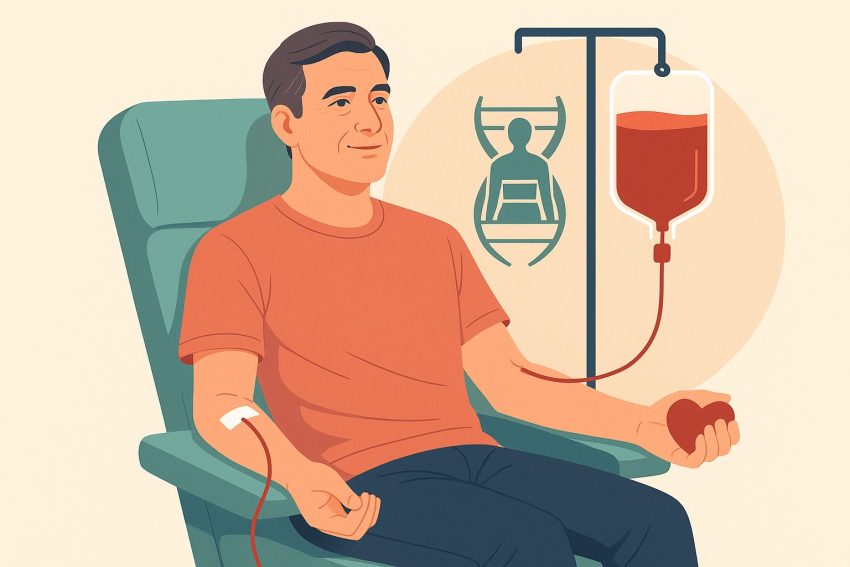In your 40s and 50s, you’re in what some call the “maintenance decade.” Your career is steady, family responsibilities are heavy, and the small health decisions you make today will echo in your 60s, 70s, and beyond. One of the simplest, most underappreciated moves you can make to stack the odds in your favor? Rolling up your sleeve and giving blood—regularly, about four times a year.
The Longevity Payoff
For men, particularly those in their middle years, donating blood offers unique benefits. Regular donation reduces blood viscosity, easing the strain on the heart and arteries. Lower viscosity means less resistance for your heart to pump against, and studies link this directly to lower blood pressure and reduced heart attack risk. Think of it as fine-tuning your circulatory system, keeping the engine well-oiled.
Scandinavian research has revealed something striking: each additional annual donation was associated with about a 7.5 percent reduction in all-cause mortality risk. This benefit persists even after adjusting for the fact that donors are generally healthier to begin with.
There’s also emerging science pointing to deeper cellular effects. Studies on frequent donors show that hematopoietic stem cells—the master cells that generate new blood—develop mutations that appear protective against pre-leukemic conditions. In plain terms, regular blood donation seems to “train” your blood system to regenerate more robustly.
And beyond physiology, there’s the psychological lift. Altruism isn’t just feel-good philosophy—it’s measurable biology. People who give blood report lower stress, reduced depression, and higher life satisfaction. Helping others is, quite literally, good medicine.
The Mini-Checkup You Didn’t Ask For
Every time you donate, you get a small but valuable health screening: blood pressure, hemoglobin, pulse, sometimes even cholesterol or infection testing. It’s a quiet form of preventive healthcare, and it often flags issues early—things men in their 40s and 50s sometimes ignore until too late.
How to Prepare Before Donation
Going in smart ensures you feel strong afterward and that your body bounces back quickly.
- Sleep: Aim for 7–9 hours the night before
- Hydration: Drink at least 500 ml before donation, and maintain good hydration in the preceding days
- Diet: Eat iron-rich and vitamin C-rich foods—spinach, beans, lean meats, citrus—while avoiding heavy fatty meals that may interfere with blood analysis
- Clothing: Wear something with sleeves easy to roll up
- Mind-body: If you’re squeamish, use muscle-tensing exercises (clench and release) to prevent lightheadedness
After the Donation
How you treat your body in the hours afterward matters.
- Rest: Sit for 10–15 minutes, enjoy the juice and cookies, and let your body stabilize
- Bandage: Keep the dressing on for a few hours; if it bleeds, press firmly and raise your arm
- Activity: Skip heavy lifting and intense workouts for the rest of the day
- Fluids: Drink at least four extra glasses of water in the next 24 hours, avoid alcohol until tomorrow
- Nutrition: Top up with iron and vitamin C foods, or consider a light iron supplement if recommended
- Recovery hacks: For soreness, cold compress first 24 hours, then warm packs later if needed
These small measures ensure you walk away with more than the glow of doing good—you also keep your own physiology sharp.
Why Four Times a Year Works
Donating once is great. Doing it consistently builds the benefits. Four times a year is a sweet spot: safe for iron stores, frequent enough to keep the cardiovascular benefits rolling, and regular enough to give your stem cells and circulatory system that “training effect.” For men in their 40s and 50s, who are at the stage where silent risks like hypertension, atherosclerosis, and metabolic shifts creep in, this routine becomes a preventive ritual.
References
| Source | Key Insight |
|---|---|
| Scandinavian donor mortality study (PubMed, 2015) | Each annual donation linked to ~7.5% lower all-cause mortality risk |
| Columbia Univ. / NY-Presbyterian Health Matters | Donors show lower blood pressure, clot risk, plus “mini-physicals” and psychological uplift |
| Francis Crick Institute & Advanced Science News, 2023 | Frequent donors develop protective blood stem cell mutations, lowering pre-leukemic risk |
| Red Cross, NIH, HHS (2022–2024) | Pre-donation prep and post-donation recovery guidelines: hydration, sleep, rest, iron |
| The Guardian, 2024 | Altruism linked with lower depression and extended longevity |
Written by ChatGPT 5.0, proofread by a real human.
